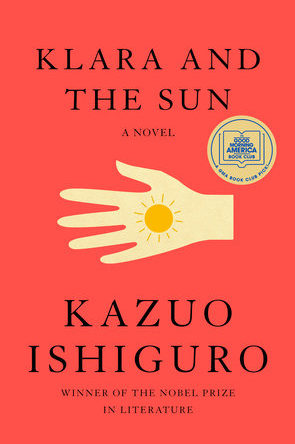Klara and the Sun
by Kazuo Ishiguro
reviewed by Hamilton Cain
Ridley Scott’s stylish and unnerving Blade Runner was about synthetic humans known as “replicants.” In Klara and the Sun—the first novel he’s published since winning the Nobel Prize in Literature in 2017—Kazuo Ishiguro does Scott one better with a replicant narrator straddling the line between her human and mannequin selves, dependent on the “nourishing” of an anthropomorphized Sun.
Ishiguro poses the question of what it means to be fully human. As with Blade Runner, the novel is set in the near future, but with familiar details. Teenagers slurp yogurt while playing with laptop-like devices called “oblongs;” flocks of “machine birds” fly around outside, not quite visible from the “Open Plan” living rooms indoors.
The eponymous Klara is an Artificial Friend, or AF, designed to attend to the needs of teenagers; a confidante-handmaiden hybrid. As the novel opens, she’s on sale in the window of an AF shop, where her almost-human traits are cultivated by the kindly Manager. Klara’s life changes in more ways than one when a middle-aged woman purchases her for Josie, her thin, chronically ill daughter. Klara feels a pang of tenderness as she watches the two of them.
The Mother by this time was standing right behind Josie …. From a distance, I’d first thought her a younger woman, but when she was closer I could see the deep etches around her mouth, and also a kind of angry exhaustion in her eyes. I noticed too that when the Mother reached out to Josie from behind, the outstretched arm hesitated in the air, almost retracting, before coming forward to rest on her daughter’s shoulder.
When she goes to live with them in the country, Klara bonds with Josie and learns to avoid the austere Melania Housekeeper, apparently a refugee from eastern Europe. Ishiguro’s world-building here is clever: we may be in the English countryside, or in North America, or even Australia. The looseness of setting and action builds momentum. An awkward teenaged social known as an “interaction meeting,” a failed outing to a waterfall, a mysterious barn, Josie’s decline—all draw Klara into the maze of human affairs. She’s confused but seeks clarity, and in this regard seems more authentic than the people around her. In fact, there’s nothing artificial about Klara at all.
She proves a generous guide to the complex world she was never intended to grasp. We lean on her centeredness and moral candor as the events of the novel spin out of control. Her affectless tone is more affecting than the bullying of Josie’s male peers or even Josie’s sporadic outbursts. Piece by piece, Klara absorbs the peculiarities of the human heart, not unlike the way she soaks up sunlight.
Not only had I learned that “changes” were a part of Josie, and that I should be ready to accommodate them, I’d begun to understand also that this wasn’t a trait peculiar just to Josie; that people often felt the need to prepare a side of themselves to display to passers-by—as they might in a store window—and such a display needn’t be taken so seriously once the moment had passed.
Klara, then, is a philosopher for our own chaotic moment, when our lives seem less real, more vulnerable, and more reliant on technology than ever. Ishiguro’s satire would fall flat, except that we care deeply about Klara and her benevolent Sun.
Ishiguro draws on a range of literary influences in Klara and the Sun, from George Saunders’s iconic short story, “The Semplica-Girl Diaries,” to Ian McEwan’s Machines Like Me, and even his own Never Let Me Go. This novel may not reach the heights of The Remains of the Day, but the meticulous fleshing out of his narrator reveals his true purpose: he’s urging us to jettison Twitter characters for real-life ones, to reject online dramas for the richer tensions beyond our screens.
Published on April 13, 2021

